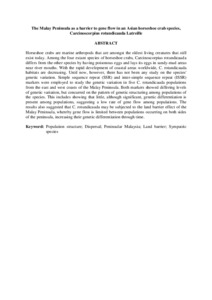Citation
A. B., Adibah and Ng, W. L. and Tan, Soon Guan
(2015)
The Malay Peninsula as a barrier to gene flow in an Asian horseshoe crab species, Carcinoscorpius rotundicauda Latreille.
Biochemical Systematics and Evolution, 60.
pp. 204-210.
ISSN 0305-1978
Abstract
Horseshoe crabs are marine arthropods that are amongst the oldest living creatures that still exist today. Among the four extant species of horseshoe crabs, Carcinoscorpius rotundicauda differs from the other species by having poisonous eggs and lays its eggs in sandy-mud areas near river mouths. With the rapid development of coastal areas worldwide, C. rotundicauda habitats are decreasing. Until now, however, there has not been any study on the species' genetic variation. Simple sequence repeat (SSR) and inter-simple sequence repeat (ISSR) markers were employed to study the genetic variation in five C. rotundicauda populations from the east and west coasts of the Malay Peninsula. Both markers showed differing levels of genetic variation, but concurred on the pattern of genetic structuring among populations of the species. This includes showing that little, although significant, genetic differentiation is present among populations, suggesting a low rate of gene flow among populations. The results also suggested that C. rotundicauda may be subjected to the land barrier effect of the Malay Peninsula, whereby gene flow is limited between populations occurring on both sides of the peninsula, increasing their genetic differentiation through time.
Download File
![[img]](http://psasir.upm.edu.my/46647/1.hassmallThumbnailVersion/The%20Malay%20Peninsula%20as%20a%20barrier%20to%20gene%20flow%20in%20an%20Asian%20horseshoe%20crab%20species%2C%20Carcinoscorpius%20rotundicauda%20Latreille.pdf)  Preview |
|
Text (Abstract)
The Malay Peninsula as a barrier to gene flow in an Asian horseshoe crab species, Carcinoscorpius rotundicauda Latreille.pdf
Download (5kB)
| Preview
|
|
Additional Metadata
Actions (login required)
 |
View Item |

